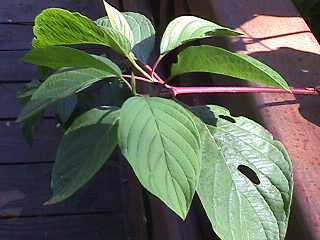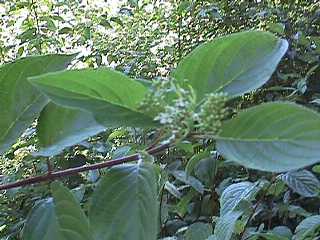

General Species Description
- Cornus sericea is a highly branched woody deciduous shrub that can grow up to fifteen feet in the wild and may be seen used as a ornimental. The bark and branches are red in the fall to spring and turn green in the summer. The bark of older branches turns grey. The leaves arise opposite on the branches with terminal inflorescences. Cornus sericea is found growing in dense thickets in wetlands. A distinguishing feature of the leaves is that if it is pulled apart carefully, veins remain connected to the midrib by thin silvery strands which are vascular bundles.
Leaves
- The leaves are simple and ovate in shape with intire margins and arise opposite on the shrub. They are bright green in color with prominant veins and the underside of the leaf is slightly pubescent. The veins are numerous and are noticably curved in a new moon shape extending from the midvein to the pointed leaf tip.
Inflorescence/Flowers
- The inflorescences are flat-topped clusters comprised of green buds and many small, white flowers. The flowers have four petals. The shrub blooms May to June.
Fruits
- The fruits are white round berries when mature.
Habitat
- Cornus sericea occurs in soils that are saturated for at least a portion of the growing season. Common on the edges of lakes, within wetlands, and along streams. Cornus sericea prefers nitrogen-rich soils, and can tolerate a fluctuating water table. Associates include black cottonwood (Populus balsamiferi) and red alder (Alnus rubra) and willow species in alluvial floodplain forests and it is also found in willow scrub-shrub wetlands.
Range
- Alaska to southern California, east to Idaho and Nevada. Common in lower elevation shrubby wetlands and stream courses of the Northwest. Occurs in all countries in our area.
Similar Species
- The deep bright red stems from winter to spring on Cornus sericas are very distinctive. Pacific dogwood (Cornus sericea) has similar leaves, but the bark and twigs are brown and the flowers are surrounded by pink-white bracts.
Ecological Value
- Wildlife eat the twigs, leaves, and fruits and the shrubs are commonly used for nesting by sonbirds.
Human Value
- Native Americans used the inner bark in tobacco mixtures and teas, and for tanning or drying animal hides. Some tribes ate the white, sour berries, while others used the branches for arrow-making, stakes, or other tools. It is often used as an ornimental.
References
- Cooke, S.S.,ed. 1997. A Field Guide to the Common Wetland Plants of Western Washington and Northwest Oregon.
Seattle Audubon Society and Washington Native Plant Society. Seattle Audubon Society, Seattle WA,190pp.
2) Hitchcock and Cronquist.1973 Flora of the Pacific Northwest University of Washington Press pp339
This page was created by: Susan Muller, August 2000
Return to Northwest Oregon Wetland Plants Project